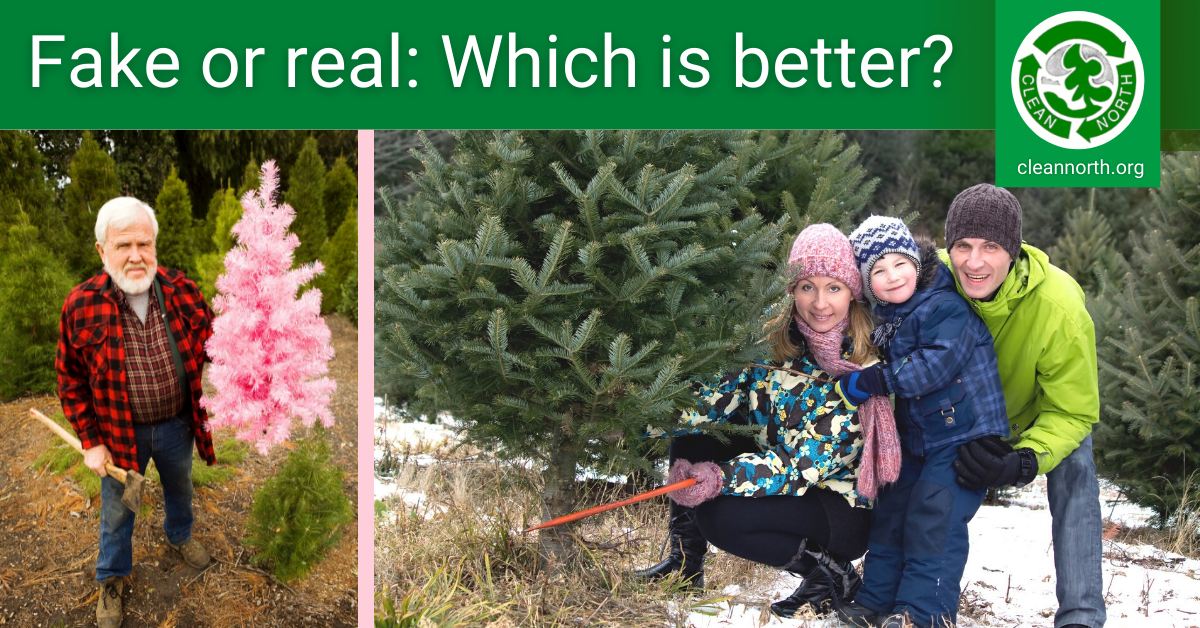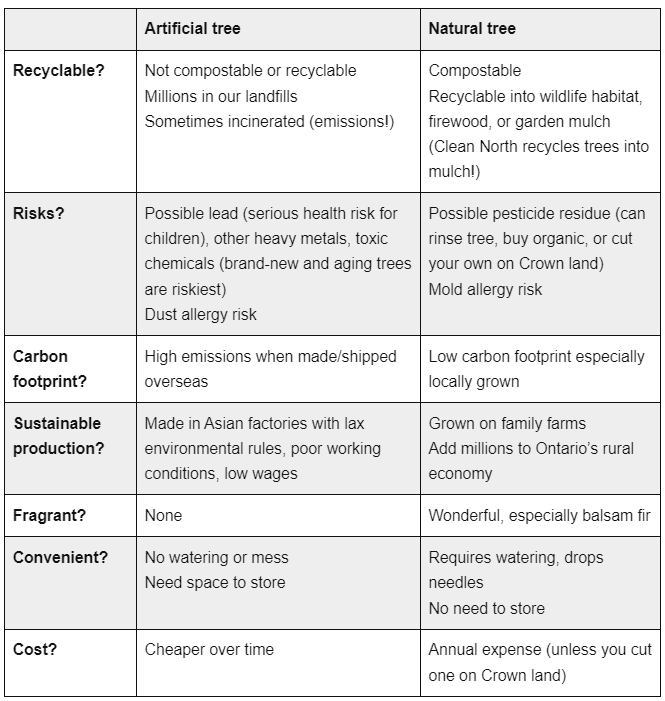
More and more people are turning to artificial Christmas trees. Some like the convenience, while others worry that cutting down real trees is bad for the environment. But it turns out that artificial trees are way less green than natural ones. Below are factors to consider when weighing whether to stick with a plastic tree or go natural.
One major concern with artificial trees is some contain lead and may drop lead dust onto your floor. This poses a special risk to babies and toddlers. There is no safe level of lead exposure. New and aging trees post the greatest risk.
Pros and cons of fake vs. real

Recyclability?
- Artificial tree:
- Not compostable or recyclable
- Millions in our landfills, sometimes incinerated (emissions!)
- Real tree:
- Compostable
- Recyclable into wildlife habitat, firewood, or mulch (Clean North recycles trees into mulch!)
Risks?
- Artificial:
- Possible lead, a serious health risk for children, other heavy metals, toxic chemicals (brand-new and aging trees are riskiest)
- Dust allergy risk
- Real:
- Possible pesticide residue (can rinse tree, buy organic, or cut your own on Crown land)
- Mold allergy risk
- Non-local trees could give invasive species a lift
Carbon footprint?
- Artificial: High emissions when made/shipped overseas
- Real: Low carbon footprint especially locally grown
Sustainable production?
- Artificial: Usually made in Asian factories with lax environmental rules, poor working conditions, low wages
- Real: Grown on family farms, add millions to Ontario’s rural economy
Fragrance?
- Artificial: None
- Real: Wonderful, especially balsam fir
Convenience?
- Artificial: No watering or mess, need space to store
- Real: Requires watering, drops needles, no need to store
Cost?
- Artificial: Cheaper over time depending on how long you own it
- Real: Annual expense (unless you cut one on Crown land)
Bottom line
Natural Christmas trees have a smaller impact on both the environment and human health.
Still thinking artificial?
We understand that some people may not be able to deal with getting and setting up a natural tree. But keep in mind it can be difficult to determine which artificial trees have lead or other hazardous substances in them. Look for ones that have more polyethylene and less polyvinyl chloride (PVC), as the former is generally safer. And remember that the newest and oldest artificial trees are the most likely to shed lead particles.
Tips for real trees
If you decide to go for a natural tree, some tips for keeping it fresh:
- Try to find a local, fresh-cut tree rather than a tree trucked in from somewhere else. It will last longer and has a smaller carbon footprint.
- Cut two inches off the stem before you put it into the stand.
- Keep the water in the stand full for at least the first three days.
- Keep the tree away from heat sources and fans, which can dry it out.
What about potted trees?
A potted native conifer is great! No lead, no chemicals, and no waste. But not everyone has space to keep a potted tree inside until it can be planted. If you choose a potted tree:
- Put it by a bright window (preferable south or west), keep it watered, and make sure it has good drainage.
- Do not plant outside until spring.
Norfolk Island pines make excellent house plants and are perfect for people who want a small tree they can keep year round. But they are not winter hardy.
Good luck with your decision!
And remember, if you choose a real tree, bring it to Cambrian Mall after Christmas, and we’ll chip it into garden mulch.
Need help getting your tree to the mall? Watch for information about our tree delivery service, a partnership with Just Junk.




